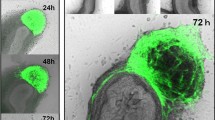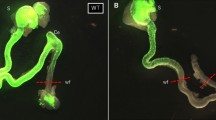Abstract
Purpose
Cell therapy is a promising approach to treat enteric neuropathies such as Hirschsprung disease (HD). Recent studies have reported that enteric neurons derived from stem cells (ENCCs) can be grafted into the HD colon. Thus, we investigated the migration and generation of enteric neurospheres from SOX10-VENUS+ mice after transplantation into control or Ednrb KO mice, which are a model of HD.
Methods
Single-cell suspensions were isolated from the fetal guts of SOX10-VENUS+ mice E13.5 and dissociated. These cells were cultured for 7 days under non-adherent conditions to generate neurospheres, which were co-cultured with dissociated control or SOX10-VENUS− Ednrb KO mouse gut on E13.5. 4 days later, these cells were fixed and the expression of the neuronal marker, Tuj1, was evaluated.
Results
Transplanted neurospheres had undergone abundant neuronal migration and differentiation of ENCCs in the control gut compared with the HD gut. The average length and intersections were significantly decreased in HD colon compared with controls (p < 0.05), and a similar pattern was observed in the HD small intestine (p < 0.05).
Conclusions
We demonstrated that transplanted ENCCs did not differentiate properly in HD gut. These results highlight the importance of the neuronal environment in the recipient gut for enteric nervous system development.



Similar content being viewed by others

References
Furness JB (2012) The enteric nervous system and nerurogastroenterology. Nat Rev Gastroenterol Hepatol 9(5):286–294
Obermay F, Hotta R, Enomoto H et al (2013) Development and developmental disorders of the enteric nervous system. Nat Rev Gastroenterol Hepatol 10(1):43–57
Burns AJ, Hofstra RMW (2016) The enteric nervous system. From embryology to therapy. Dev Biol 15(41782):127–128
Parikh DH, Tam PK, Lloyd DA et al (1992) Quantitative and qualitative analysis of the extracellular matrix protein, laminin, in Hirschsprung`s disease. J Pediatr Surg 27(8):995–996
Kawaguchi J, Nichols J, Gierl MS et al (2010) Isolation and propagation of enteric neural crest progenitor cells from mouse embryonic stem cells and embryos. Development 137:693–704
Shibata S, Yasuda A, Renault-Mihara F et al (2010) Sox10-Venus mice: a new tool for real-time labeling of neural crest lineage cells and oligodendrocytes. Mol Brain 3:31
Fujiwara N, Miyahara K, Nakazawa-Tanaka N et al (2016) Altered differentiation of enteric neural crest-derived cells from endothelin receptor-B null mouse model of Hirschsprung’s disease. Pediatr Surg Int 32(12):1095–1101
Heuckeroth RO (2018) Hirschsprung disease—integrating basic science and clinical medicine to improve outcomes. Nat Rev Gastroenterol Hepatol 15(3):152–167
Pan WK, Zheng BJ, Gao Y et al (2011) Transplantation of neonatal gut neural crest progenitors reconstructs ganglionic function in benzalkonium chloride-treated homogenic rat colon. J Surg Res 167(2):e221–e230
Lindley RM, Hawcutt DB, Connell MG et al (2008) Human and mouse enteric nervous system neurosphere transplants regulate the function of aganglionic embryonic distal colon. Gastroenterology 135(1):205-216.e6
Hotta R, Stamp LA, Foong JPP et al (2013) Transplanted progenitors generate functional enteric neurons in the postnatal colon. J Clin Invest 123(3):1182–1191
Mucci MA, Pasricha F (2007) Neural stem cells for the treatment of disorders of the enteric nervous system: strategies and challenges. Dev Dyn 236(1):33–34
Druckenbrod NR, Epstein ML (2009) Age-dependent changes in the gut environment restrict the invasion of the hindgut by enteric neural progenitors. Development 136(18):3195–3203
Ci H, Rauch U, Klotz M et al (2012) The microenvironment in the Hirschsprung’s disease gut supports myenteric plexus growth. Int J Colorectal Dis 27(6):817–829
Acknowledgements
The authors thank Ms Mirei Takahashi for excellent technical support.
Funding
This work was supported by JSPS KAKENHI Grant no. 19K09103.
Author information
Authors and Affiliations
Corresponding author
Additional information
Publisher's Note
Springer Nature remains neutral with regard to jurisdictional claims in published maps and institutional affiliations.
Rights and permissions
About this article
Cite this article
Fujiwara, N., Miyahara, K., Nakazawa-Tanaka, N. et al. In vitro investigation of the differentiation of enteric neural crest-derived cells following transplantation of aganglionic gut in a mouse model. Pediatr Surg Int 38, 755–759 (2022). https://doi.org/10.1007/s00383-022-05105-2
Accepted:
Published:
Issue Date:
DOI: https://doi.org/10.1007/s00383-022-05105-2



